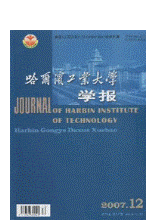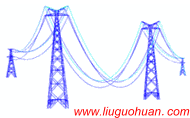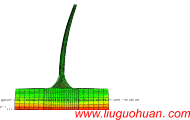A Simplified Optimization Strategy For Nonlinear Tuned Mass Damper In Structural Vibration Control作者: Wei Guo, Hong-Nan Li, Liu-Guohuan, Zhi-Wu Yu |
||||||
下载次数:
次 更多论文下载...
PDF格式(左键浏览,右键另存):
DOI: 10.1002/asjc.476
Abstract:In this paper, a simplified optimization strategy for the nonlinear tuned mass damper (TMD) is presented, and the optimal parameter setting can be simply determined, by which the nonlinear TMD is effective over a wide frequency range. In the given numerical model, the nonlinear TMD is attached to the structure, which is represented by a single-degree-of-freedom system, and the environmental load is assumed to be the Gaussian white noise process. Governing differential equations of motion of the coupled structure-TMD system are derived, and the equivalent linearization method is introduced in the numerical calculation.The standard deviation of the structural displacement is adopted as the optimized objective function. Furthermore, it is pointed out that the response of the system can be controlled in a case of multiple probable steady-state processes caused by the nonlinearity of the stiffness element. Different from the linear TMD, the performance of the nonlinear TMD may be influenced by the excitation. Thus, the performance sensitivity of optimal nonlinear TMD is investigated with different excitation intensities and structural damping ratios. The results show that the sensitivity may limit the engineering applications of nonlinear TMD. Keywords:Tuned mass damper, nonlinear stiffness element, equivalent linearization, optimization strategy, sensitivity Introduction In recent years, many high rise buildings, towers, chimneys,and bridges, characterized by flexibility and light damping have been constructed. These may experience large vibrations when subjected to environmental loads such as wind, wave, and earthquake excitation, and the vibration may lead to fatigue damage or structural collapse. Thus, some measures for vibration control are often taken in the design phase, or by retrofitting an existing structure, to reduce the structural responses. The common sense approach to control the structural vibration consists of adding damping, either passively or actively. The damping dissipates some of the input vibration energy of a structure by transforming it to heat or transferring it indirectly to any connected energy dissipation devices. Structural vibration control, generally classified as active, semi-active and passive control, is an advanced technology in engineering. It enhances human comfort by reducing the excessive structural vibration with energy dissipation devices or control systems in structures. Compared with active and semi-active controls, the passive control devices have received significant attention, with the advantages of low cost, no power requirements, and easy installation. The passive control devices include base isolation, viscous damper, and tuned mass damper (TMD). Among the passive techniques, the TMD technique has been investigated and proven to be efficient, when it is properly tuned, for both wind and earthquake excitation. Furthermore, it has been installed in several structures around the world. Representative examples of this technique’s engineering application are: the Centrepoint Tower in Australia (TMD, 1987), John Hancock Tower in America (TMD, 1975), Citicorp Center in America (TMD, 1980), and Chiba Tower in Japan (TMD, 1992). The TMD is an additional mass attached to the primary structure by a spring and a damper in parallel. It was first studied by Frahm (1909) in order to reduce the vibration of a primary structure without damping. Since then, many studies have been carried out on the effectiveness of linear TMD on the vibration control response of linear structures [1–3]. In order to achieve the optimal vibration control of a structure, the stiffness and damping coefficients of the TMD should be chosen appropriately. A number of optimal solutions of the TMD’s parameters for various types of excitations and various optimization objectives have been given. For the case of a primary structure without damping, the fixed point theory has been proposed by Den Hartog [1], in which the excitation was assumed to be harmonic.Warburton andAyorinde also listed the closed-form expressions of the optimal parameters of theTMD under different types of excitation [2]. For the structure with damping characteristics, there is not usually a closed-form expression in terms of structural parameters. As the external excitation frequency is generally not fixed, the linear TMD poses problems that while the resonant peaks can become very steep, the response in the neighborhood of existing structural resonant frequencies may be adversely affected. At the same time, it is difficult to obtain exact dynamic solutions of the structure in practical engineering because of the inevitable perturbation of structural physical parameters, so the designed optimal control effect of linearTMD is often hard to achieve. Due to the shortcomings of linear TMD, some researchers have proposed many kinds of improved TMD for providing a better performance in vibration control, such as multiple tuned mass dampers (MTMD) and double tuned mass dampers (DTMD). Igusa has analyzed the vibration control capabilities of multiple tuned mass dampers with natural frequencies distributed over a frequency range [4,5], which is also effective in a wider frequency range than the linear TMD. In the research mentioned above, the stiffness and damping elements connected to the additional mass are assumed to be linear. Since the 1980s, several researchers have also studied the performance of nonlinear TMD for structural vibration suppression, in which the stiffness or the damping elements, or both, were assumed to behave according to the given nonlinear law. The introduction of the nonlinear property in the TMD device would improve the performance of linear TMD to a certain extent. Roberson analyzed the performance of the nonlinear TMD with a Duffing spring, and the study shows that the nonlinear TMD is able to gain a wider vibration suppression bandwidth than the linear TMD [6]. Carter and Lin’s work indicates that the TMD with a softening spring connected to the structure with a characteristic hardening spring, is more effective [7]. Hunt and Nrssen investigated the response of a structure when a nonlinear softening Belleville spring was used in the TMD device and the result shows that the vibration suppression bandwidth could be doubled by this means [8]. Inaudi and Kelly studied the nonlinear TMD in which the friction damper is adopted as a means of energy dissipation [9]. Abé proposed a design method of nonlinear TMD for structures with bilinear hysteresis subjected to harmonic excitation [10]. In Ricciardelli’s work [11], the closed-form expressions of optimal parameters for the TMD with friction damper and amplitudes of multiple steady-state vibration were presented. Rüdinger has studied the optimal TMD with the nonlinear viscous power law damping under white noise excitation [12,13]. According to the literature above, it can be considered that the nonlinear TMD is more effective than the linear TMD over a wide frequency range. However,another general point concerning the nonlinear TMD is that the nonlinearity may lead to dangerous instabilities and unwanted consequences, which in some cases may result in amplification rather than reduction of the vibration amplitudes. Some researchers have also pointed out that the nonlinear system vibration can be controlled in the intended steady state through active or passive techniques, known as chaos control. Thus, the unfavorable effect due to the nonlinearity can also be avoided by appropriate parameter setting. Meanwhile, while the performance of the linear TMD has no correlation with the excitation intensity and structural damping, the actual response and optimal parameter values of the nonlinear TMD would depend on both excitation intensity and structural damping, which may limit its engineering application. In this paper, theTMD with Duffing spring is taken into account. The governing differential equations of motion for the coupled structure-nonlinear TMD system are derived and solved under the Gaussian white noise excitation. The system is analyzed by the equivalent linearization method with the area under the square of absolute value of the frequency response function as the objective, which is proportional to the variance of the response (square of the standard deviation). The equivalent linearization method is adopted as the calculation method of the standard deviation of the response, which is accurate enough for the weakly nonlinear case. Meanwhile, a simplified optimization strategy for the nonlinear TMD is proposed, according to which the nonlinear TMD is designed effectively in a wider frequency range. In addition, the phenomenon of multiple steady-state response due to the nonlinearity is investigated based on the random vibration theory. At the end of this paper, a sensitivity study is also conducted to investigate the influence of the excitation intensity and structural damping on the performance of nonlinear TMD. Conclusions In this paper, the seismic response of coupled structurenonlinear TMD system subjected to Gaussian white noise excitation is calculated, in which the nonlinear element is assumed to be the Duffing spring. In the numerical analysis, the equivalent linearization method, which is accurate enough for the weakly nonlinear case, is used and the standard deviation of the response is adopted as the optimization index. Meanwhile, a simplified optimization strategy for the nonlinearTMD is presented, according to which the nonlinearTMD can be designed effectively in a wider frequency range than that of the linear TMD. Furthermore, the multiple steady states due to the introduction of nonlinearity are investigated, and the sensitivity of nonlinear TMD to the excitation intensity and structural damping ratio is also studied, which points out that the sensitivity may limit the engineering application of nonlinearTMD. In the end of this paper, it is found that the nonlinearTMD is more applicable for determinate excitation, like wind, and it is also observed that the research in this paper emphasizes the simplified optimization strategy but not the applicability of the nonlinear TMD. References: 1. Den Hartog, J. P. Mechanical Vibrations, McGraw-Hill,New York (1947). 2. Warburton G. B. “Optimum absorber parameters for various combinations of response and excitation parameters,” Earthq. Eng. Struct. Dyn., Vol. 10, pp. 381–491(1982). 3. Setareh, M. and R. Hanson, “Tuned mass dampers to control floor vibration from humans,” J. Struct. Eng.,ASCE, Vol. 118, No. 3, pp. 741–762 (1992). 4. Xu, K. and T. Igusa, “Dynamic characteristics of multiple substructures with closed spaced frequencies,” Earthq. Eng. Struct. Dyn., Vol. 21, pp. 1059–1070 (1992). 5. Igusa, T. and K. Xu, “Vibration control using multiple tuned mass dampers,” J. Sound Vibr., Vol. 175, No. 4, pp. 491–503 (1994). 6. Roberson R. E. “Synthesis of a nonlinear dynamic vibration absorber,” J. Frankl. Inst.-Eng. Appl. Math.,Vol. 254, pp. 205–220 (1952). 7. Carter, W. J. and F. C. Lin, “Steady-state behavior of nonlinear dynamic vibration absorber,” J. Appl. Mech.,Vol. 28, No. 1, pp. 67–70 (1961). 8. Hunt, J. B. and J. C. Nrssen, “The broadband dynamic vibration absorber,” J. Sound Vibr., Vol. 83, No. 4, pp.573–578 (1982). 9. Inaudi, J. A. and J. M. Kelly, “Mass damper using friction-dissipating devices,” J. Eng. Mech.,Vol. 121, No.1, pp. 142–149 (1995). 10. Abé M. “Tuned mass dampers for structures with bilinear hysteresis,” J. Eng. Mech., Vol. 122, No. 8, pp. 797–800(1996). 11. Ricciardelli, F. and B. J. Vcikey, “Tuned vibration absorbers with dry friction damping,” Earthq. Eng.Struct. Dyn., Vol. 28, pp. 707–723 (1999). 12. Rüdinger F. “Optimal vibration absorber with nonlinear viscous power law damping and white noise excitation,”J. Eng. Mech. ASCE, Vol. 132, No. 1, pp. 46–53 (2006). 13. Rüdinger F. “Tuned mass damper with nonlinear viscous damping,” J. Sound Vibr., Vol. 300, pp. 932–948 (2007). 14. Roberts, J. B. and P. D. Spanos, Random Vibration and Statistical Linearization, Wiley, Chichester (1990). 15. Crandall, S. H. and W. D. Mark, Random vibration in mechanical systems, Academic Press Inc, New York(1963). 16. Ayorinde, E. O. and G. B.Warburton, “Minimizing structural vibrations with absorbers,” Earthq. Eng. Struct. Dyn., Vol. 8, pp. 219–236 (1980). 17. Warburton G. B. “Optimum absorber parameters for minimizing vibration response,” Earthq. Eng. Struct.Dyn., Vol. 9, pp. 251–262 (1981). 18. Krenk, S. and J. Hogsberg, “Tuned mass absorbers on damped structures under random load,” Probab. Eng.Mech., Vol. 23, No. 4, pp. 408–415 (2008). 19. Krenk, S. and J. Hogsberg, Tuned mass absorbers on damped structures, 7th European Conference on Structural Dynamics, Southampton (2008). 20. Gradshteyn, I. S. and I. M. Ryzhik, Table of Integrals,Series, and Products, 7th edition, Academic Press, New York (2007). |
||||||
| welcome to www.liuguohuan.net |
| 天津大学 建筑工程学院 ; 天津大学 前沿技术研究院; 国家重点实验室-水利工程仿真与安全 |







